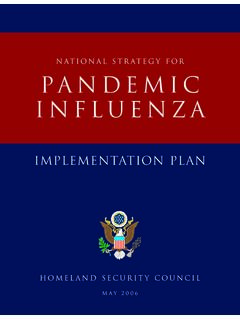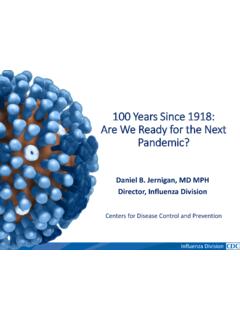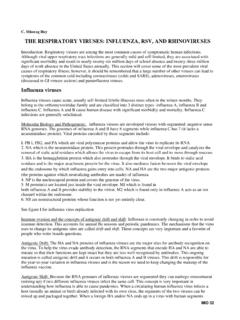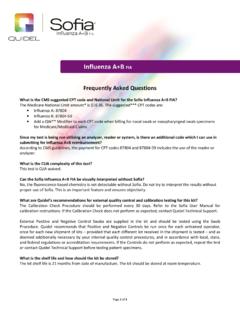Transcription of Surveillance of influenza and other respiratory viruses in ...
1 Surveillance of influenza and other respiratory viruses in the UK. Winter 2019 to 2020. Surveillance of influenza and other respiratory viruses in the UK: Winter 2019 to 2020. About Public Health England Public Health England exists to protect and improve the nation's health and wellbeing, and reduce health inequalities. We do this through world-leading science, research, knowledge and intelligence, advocacy, partnerships and the delivery of specialist public health services. We are an executive agency of the Department of Health and Social Care, and a distinct delivery organisation with operational autonomy. We provide government, local government, the NHS, Parliament, industry and the public with evidence-based professional, scientific and delivery expertise and support. Public Health England Wellington House 133-155 Waterloo Road London SE1 8UG. Tel: 020 7654 8000. Twitter: @PHE_uk Facebook: Prepared by: influenza Surveillance Section, Immunisation and Countermeasures Division, National Infection Service, PHE.
2 For queries relating to this document, please contact: Crown copyright 2020. You may re-use this information (excluding logos) free of charge in any format or medium, under the terms of the Open Government Licence To view this licence, visit OGL. Where we have identified any third party copyright information you will need to obtain permission from the copyright holders concerned. Published June 2020. PHE publications PHE supports the UN. gateway number: GW-1328 Sustainable Development Goals 15. Surveillance of influenza and other respiratory viruses in the UK: Winter 2019 to 2020. Contents Glossary 4. Executive summary 5. Background 7. Community Surveillance 9. Primary care consultations 22. Secondary care Surveillance 28. Microbiological Surveillance 39. Mortality Surveillance 51. Vaccination 55. Emerging respiratory viruses 64. Conclusions 67. Acknowledgments 69. 3. Surveillance of influenza and other respiratory viruses in the UK: Winter 2019 to 2020. Glossary ARI Acute respiratory infections COVID-19 Coronavirus Disease 2019.
3 ECDC European Centre for Disease Control ECMO ExtraCorporeal Membrane Oxygenation ECOSS Electronic Communication of Surveillance in Scotland ED Emergency department EDSSS Emergency Department Syndromic Surveillance System GP General Practitioner GPIH GP in hours GPOOH GP out-of-hours HA Haemagglutinin HDU High Dependency Unit HI Haemagglutination inhibition hMPV Human metopneumovirus HPS Health Protection Scotland ICU Intensive Care Unit ILI influenza -like illness LA Local Authority LAIV Live attenuated influenza Vaccine MEM Moving Epidemic Method MERS-CoV Middle East Syndrome coronavirus MOSA Medical Officers of Schools Association NI Neuraminidase inhibitor NIS National Infection Service ONS Office for National Statistics PCR Polymerase chain reaction PHA Public Health Agency of Northern Ireland PHE Public Health England POCT Point of care testing QIVc Cell-based quadrivalent influenza vaccine QIVe Egg-based quadrivalent influenza vaccine RCGP Royal College of General Practitioners RSV respiratory Syncytial Virus RVU respiratory Virus Unit SARS-CoV-2 Severe acute respiratory syndrome coronavirus 2.
4 SMN Specialist Microbiology Network SRF Severe respiratory Failure TIV-HD High-dose trivalent influenza vaccine UCL University College London USISS UK Severe influenza Surveillance Systems WHO World Health Organization 4. Surveillance of influenza and other respiratory viruses in the UK: Winter 2019 to 2020. Executive summary In the 2019 to 2020 season, low levels of influenza activity were observed in the community with circulation of influenza A(H3N2) dominating the season. Activity started to increase from week 47, 2019, with the length and peak of activity in general practice varying across the UK, reaching low levels in England, and medium levels in Scotland, Northern Ireland and Wales. influenza transmission resulted in medium impact through secondary care indicators (hospitalisations and ICU/HDU admissions). Peak admission rates of influenza to hospital and ICU/HDU were similar or lower than seen in the 2018 to 2019 and 2017 to 2018 seasons but higher than all other seasons since 2010 to 2011.
5 Excess all-cause mortality was seen during the influenza season in England, Scotland, Wales and Northern Ireland before the circulation of Severe Acute respiratory Syndrome coronavirus- 2 (SARS-CoV-2) in the UK. From week 12, 2020 levels of excess all-cause mortality were the highest seen in England since excess all-cause mortality began reporting, which coincides with the Coronavirus Disease 2019 (COVID-19) pandemic. The UK, as with many Northern Hemisphere countries, found that the majority of circulating influenza A(H1N1)pdm09 and A(H3N2) strains that were characterised were genetically and antigenically similar to the Northern Hemisphere 2019 to 2020. A(H1N1)pdm09 and A(H3N2) vaccine virus strains. Vaccine uptake in England varied by cohort. For the following cohorts, the vaccine uptake in England in the 2019 to 2020 season was higher than the 2018 to 2019 season: those aged 65+ ( compared to in 2018 to 2019). health care workers ( compared to in 2018 to 2019). For the following cohorts, the vaccine uptake in England in the 2019 to 2020 season was lower than the 2018 to 2019 season: those aged 6 months to under 65 years of age with 1 or more underlying clinical risk factors ( compared to in 2018 to 2019).
6 Pregnant women ( compared to in 2018 to 2019). In 2019 to 2020, the universal childhood influenza vaccine programme with live attenuated influenza vaccine (LAIV) was again offered to pre-school children aged 2. and 3 years across the UK, plus 4 year olds in Scotland and Northern Ireland. LAIV. was offered to all primary school age children across the UK. This was the first year that LAIV was offered to children in Year 6 in England. Vaccine uptake varied across the UK. 5. Surveillance of influenza and other respiratory viruses in the UK: Winter 2019 to 2020. In England: uptake in 2 and 3 year olds was , compared to in the previous season uptake in primary school age children uptake was for all year groups (Reception to Year 6) this is compared to an uptake of in the previous season (Reception to Year 5). uptake in each school year group was the same or higher than in the previous season In Scotland: uptake in the 2 to <5 year olds (not yet in school) was , compared to in the previous season uptake in primary school children was , compared to in the previous season In Northern Ireland: uptake in the 2 to <5 year olds (not yet in school) was , compared to in the previous season uptake in all primary school children was , compared to in the previous season In Wales: uptake in 2 and 3 year olds was , compared to in the previous season uptake in all primary school children was , compared to in the previous season Overall influenza vaccine effectiveness in 2019 to 2020 against a laboratory confirmed infection resulting in a primary care consultation was (95% CI to ).
7 Activity from other circulating seasonal respiratory viruses was similar overall compared to levels reported in recent years with lower levels of respiratory Syncytial Virus (RSV). seen than in previous seasons in England. The novel respiratory coronavirus SARS-CoV-2 which causes the disease Coronavirus Disease 2019 (COVID-19) emerged in Wuhan, China in December 2019. The first cases in the UK were confirmed in late January 2020. COVID-19 Surveillance in the UK. has been ongoing since January 2020. Two novel respiratory viruses which emerged in 2012 to 2013, Middle East respiratory Syndrome coronavirus (MERS-CoV) in the Middle East and avian-origin influenza A(H7N9) in Eastern China, have continued to result in human cases in affected countries. Surveillance and public health measures established in the UK for travellers returning with severe respiratory disease from affected countries are on-going. 6. Surveillance of influenza and other respiratory viruses in the UK: Winter 2019 to 2020.
8 Background Surveillance of influenza and other respiratory viruses in the United Kingdom (UK) is undertaken throughout the year and collated on behalf of the countries of the UK by the influenza Surveillance Team at Public Health England's National Infection Service (PHE NIS). This is in collaboration with teams within PHE, Health Protection Scotland1, Public Health Wales2 and the Northern Ireland Public Health Agency3, who are each responsible for monitoring influenza Surveillance for their respective countries. Weekly outputs are normally published during the winter season between October (week 40). and May (week 20) the period when influenza typically circulates4. In the 2019 to 2020. season, reports were published weekly between week 40, 2019 and week 9 2020 and fortnightly thereafter. A variety of data sources are collated to provide information on circulating influenza strains (including antigenic and genetic characterisation) and antiviral resistance and the timing of influenza activity and to provide rapid estimates of influenza -related burden within the community, on the health service and in excess all- cause mortality.
9 In addition, in-season and end-of-season monitoring of seasonal influenza vaccine uptake and vaccine effectiveness is undertaken. Background information on the data sources covered in this report has been previously described5. The Moving Epidemic Method (MEM)6 is used by the European Centre for Disease Prevention and Control (ECDC) to standardise reporting of influenza activity across Europe. It has been adopted by the UK and is publicly presented for GP. influenza -like illness (ILI) consultation rates for each UK scheme, for the proportion of samples positive for influenza through the respiratory DataMart scheme and for the hospitalisation and intensive care unit (ICU) admissions rate in the UK Severe influenza Surveillance System (USISS) sentinel and mandatory schemes. During the 2019 to 2020 season, the roll-out of the licensed live attenuated influenza vaccine (LAIV) has continued and has been completed for children of primary school age across the UK. In England, LAIV was offered to all 2 and 3 year olds through primary care and to children of school age Reception, Year 1, Year 2, Year 3, Year 4, Year 5 and Year 6 (4 to 10 rising to 11 year olds) through schools this year.
10 This is the first influenza season in England where Year 6 have been offered vaccination through 1 Health Protection Scotland. 2 Public Health Wales. 3 Public Health Northern Ireland. 4 Public Health England (PHE). 5 Health Protection Agency. Surveillance of influenza and other respiratory viruses in the UK: 2011-2012 report. Available from: 939. 6 Vega T, et al. influenza Surveillance in Europe: establishing epidemic thresholds by the Moving Epidemic Method. influenza and other respiratory viruses 2012. doi: 7. Surveillance of influenza and other respiratory viruses in the UK: Winter 2019 to 2020. the schools' programme, meaning that from the 2019 to 2020 season all children of primary school age are eligible. Additional influenza vaccination activity for children was also carried out with strategies varying by country of the UK. In England and Wales, 2 and 3 year olds were offered in primary care and in Scotland and Northern Ireland, vaccination was offered to 2 to <5. year olds (not yet in school).













